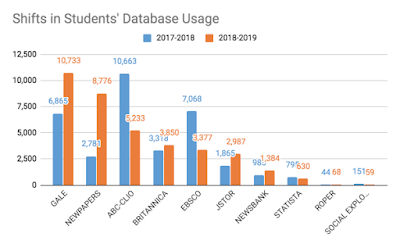As we move into budget season, we reflect on how students use our collection. This year, we noticed a few trends we wanted to share.
Students are borrowing more books!
In response to a slight dip in circulation in 2017-2018, we amped up our independent reading program this year. As of October 18, 2019, our booktalking activity is up 220% (16 classes in September and October), our print book circulation is up 20%, and our eBook circulation is up 25% as well.

While the graph below shows that student use of ABC-CLIO, EBSCO, and Statista dipped last year, use of Gale (social studies research database), the newspaper collection (Christian Science Monitor, Hartford Courant, Los Angeles Times, New York Times, Wall Street Journal and the Washington Post), and JSTOR (peer-reviewed academic journal articles) doubled.

This may sound like a mixed report, but it is a great one. It tells us that our instruction has been effective. In 2018-2019, we learned from reviewing student work that students were not selecting resources that were appropriate to their inquiry tasks. We built new instructional experiences designed to improve higher-order thinking and source-selection skills. This graph shows that students used fewer reference resources and doubled their use of more challenging materials. Here are some sample lessons:
- Absolutism (10th grade Global History II)
- Enlightenment (10th grade Global History II)
- Napoleon (10th grade Global History II)
- Junior Research Paper (Junior English)
While we would ideally love to have all students shift their research to the rigorous databases, we still need to subscribe to materials that will meet the learning needs of our incoming 9th graders. Britannica, ABC-CLIO, and EBSCO help us meet their needs.
- Is Geography Destiny (9th grade Global I)
It is clear that we are visiting 10th-grade history classes with these lessons on distinguishing references from more substantive content quite regularly. For most classes, we will see them at least once more for Imperialism, and possibly also before that for the Industrial Revolution. Our aim is to have our current sophomores ready for their two required research papers (English in the fall and social studies in the spring) right at the start of their junior year so that we can focus our junior year instruction on inquiry synthesis, not source selection.
If we were to create a macro picture of our library program’s inquiry instruction, it would look something like this:

We construct this learning around social studies and English because those are required courses. Students have more flexibility in selecting their math, science and world languages classes, so we tend to focus our assured experiences in other disciplines. This is not to say that we do not work with other disciplines, only that we acknowledge that our instruction in those courses will not have a universal impact.






